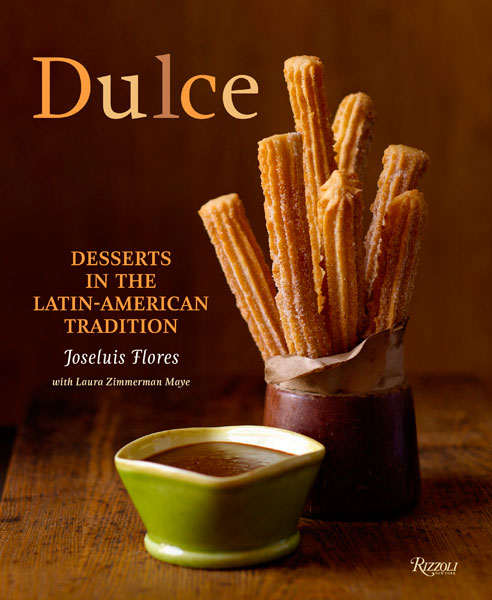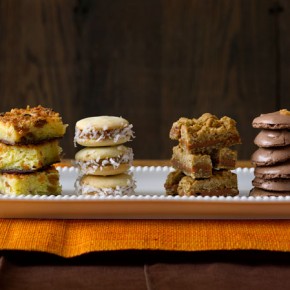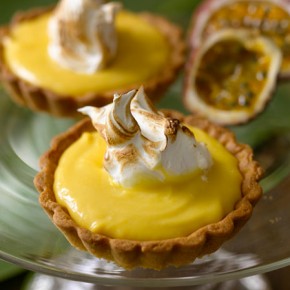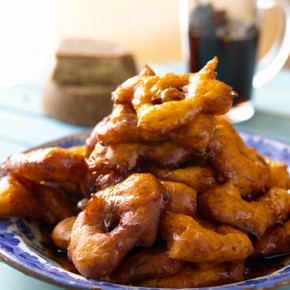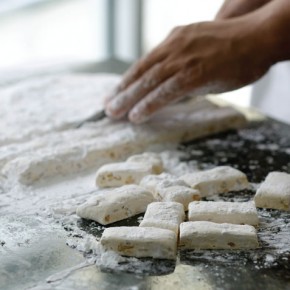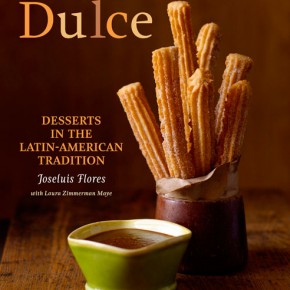Excerpts from the book , by Joseluis Flores, with Laura Zimmerman Maye:
Cajeta
Cajeta is a goat’s milk caramel similar to dulce de leche (cow’s milk-caramel originally from Argentina) or manjar blanco (what they call dulce de leche in Peru). In Mexico, it is traditionally sold in small, thin wooden boxes, or cajas, on the streets or in the open-air markets. The boxes keep the cajeta fresh and seal in the flavors—typically either ron (rum), quemada (caramelized; it tastes like a slightly bitter burnt caramel), or vanilla. Cajeta is truly a staple in every Mexican home and is used for everything from a spread for toasted bread or fresh bolillo (like a Mexican baguette), to an ingredient for lollipops, candies, or turrones (nougats), to a stuffing for crêpes. The Morelianas, from Morelia, Michoacán, in Mexico, even make a deliciously thick cajeta mixed with pecans or almonds and wrapped in brightly colored parchment paper.
Just as goat’s milk brings a certain richness and pleasant tang to some of my favorite cheeses, it also brings an unmistakable depth of flavor to this caramel. These days, it is fairly easy to track down goat’s milk at some of the specialty or more organic- or health-food-oriented groceries. And it is worth the time to find it, make a fresh cajeta, and taste one of the traditional flavors of Mexico.
Use it just as you might Nutella as a sweet spread for just about everything: bread, muffins, waffles, pound cake, croissants, or make Flan de Cajeta, which requires only 2 cups of this caramel, so thankfully you’ll have some leftovers from this recipe. Of course, you can buy it in a jar in a pinch. One of the favorite brands in Mexico is Coronado, and it’s certainly decent. You can find it and other brands pretty easily all over Mexico and in the United States. I still often have a jar of it at home to use for last-minute snacks.
Cajeta Recipe
Yields 3 cups:
- 4 cups whole goat’s milk 950 milliliters
- 4 cups granulated sugar 800 grams
- 1 cinnamon stick
- 1 teaspoon baking soda
- 1/2 cup glucose or corn syrup 120 milliliters
In a heavy, medium-sized saucepan over medium heat, combine all the ingredients and bring to a boil. Lower the heat and simmer, stirring frequently, until thick and golden brown (1 to 2 hours). The liquid will reduce to about 3 cups. Remove the cinnamon stick and chill the cajeta, tightly covered in the refrigerator, for at least 4 hours, preferably overnight. The cajeta can be stored in an airtight container in the refrigerator for 2 months or even at room temperature for about 10 days.
Flan de Cajeta (Goat’s Milk Caramel Flan)
This dessert is at once rich and refreshing—a great one for any time of year. I like to use vanilla extract here, since the color of the flan is so light and the black speckles you get from vanilla beans can diminish the effect. It’s worth it to make the cajeta from scratch. The depth of flavor from a true cajeta really makes this dish. As a garnish, try your choice of sliced fresh fruit and toasted nuts.
Flan Recipe
Serves 10:
- 11⁄2 cups evaporated milk 360 milliliters
- 11⁄4 cups whole milk 300 milliliters
- 1⁄2 cup heavy cream 120 milliliters
- 1 tablespoon vanilla extract
- 1⁄4 cup Gran Marnier 60 milliliters
- 1 pinch salt
- 2 cups cajeta (goat’s milk caramel) 455 grams
- 6 whole eggs
- 2 egg yolks
In a microwave oven, bain-marie, or pan set over gently simmering water, slightly reheat the caramel until just pourable. Pour 1/8 inch into the bottom of each of 10 (6-ounce) ramekins. Preheat the oven to 325° F.
In a medium-sized saucepan over high heat, bring the evaporated milk, whole milk, cream, vanilla extract, Grand Marnier, and salt to a boil, whisking constantly, being careful not to burn. Remove from the heat and whisk in the cajeta until melted. Chill in the refrigerator until completely cool (about 30 minutes).
In a large bowl, whisk together the eggs and yolks. Continue whisking and slowly pour the cooled cream mixture into the egg mixture. Pour the custard through a fine sieve into a clean bowl, preferably one with a spout, to remove any bits of egg. Pour the custard over the caramel in the ramekins (fill to about 1/8 inch from the top), place them in a water bath, and cover the whole pan with foil.
Bake for 30 to 35 minutes, or until the custards are set (a knife inserted in the center should come out clean). The center will still look a little loose, but the custards will continue cooking after they are removed from the oven. Carefully remove the baking dish from the oven, lift out the ramekins using tongs, and let them rest for at least 20 minutes. Move them to the refrigerator and chill for at least 4 hours, preferably overnight. When ready to serve, invert a ramekin onto each serving plate and gently tap the bottom with the end of a butter knife to help undo the mold.
-December 2010
Dulce, Desserts in the Latin American Tradition, By Joseluis Flores, with Laura Zimmerman Maye, (Rizzoli, May 2010) wwwrizzoliusa.com
-
Latin Coconut Bars (Cocadas). © Ben Fink from Dulce: Desserts in the Latin Tradition by Joseluis Flores, Rizzoli New York, 2010.
-
Apple Empanadas (Empanadas de Manzana). © Ben Fink from Dulce: Desserts in the Latin Tradition by Joseluis Flores, Rizzoli New York, 2010.
-
Passion Fruit Tart (Tartaleta de Maracuya). © Ben Fink from Dulce: Desserts in the Latin Tradition by Joseluis Flores, Rizzoli New York, 2010.
-
Peruvian Sweet Potato and Pumpkin Fritters with Spiced Syrup (Picarones con Miel de Especias). © Ben Fink from Dulce: Desserts in the Latin Tradition by Joseluis Flores, Rizzoli New York, 2010.
-
Nougat Candy with Almond and Cashews. © Ben Fink from Dulce: Desserts in the Latin Tradition by Joseluis Flores, Rizzoli New York, 2010.
-
Goat’s Milk Caramel Flan w/Carmalized Nectarines and Sugar Coated Nuts (Flan de Cajeta). © Ben Fink from Dulce: Desserts in the Latin Tradition by Joseluis Flores, Rizzoli New York, 2010.
-
Dulce: Desserts in the Latin Tradition
- Latin Coconut Bars (Cocadas). © Ben Fink from Dulce: Desserts in the Latin Tradition by Joseluis Flores, Rizzoli New York, 2010.
- Apple Empanadas (Empanadas de Manzana). © Ben Fink from Dulce: Desserts in the Latin Tradition by Joseluis Flores, Rizzoli New York, 2010.
- Passion Fruit Tart (Tartaleta de Maracuya). © Ben Fink from Dulce: Desserts in the Latin Tradition by Joseluis Flores, Rizzoli New York, 2010.
- Peruvian Sweet Potato and Pumpkin Fritters with Spiced Syrup (Picarones con Miel de Especias). © Ben Fink from Dulce: Desserts in the Latin Tradition by Joseluis Flores, Rizzoli New York, 2010.
- Nougat Candy with Almond and Cashews. © Ben Fink from Dulce: Desserts in the Latin Tradition by Joseluis Flores, Rizzoli New York, 2010.
- Goat’s Milk Caramel Flan w/Carmalized Nectarines and Sugar Coated Nuts (Flan de Cajeta). © Ben Fink from Dulce: Desserts in the Latin Tradition by Joseluis Flores, Rizzoli New York, 2010.
- Dulce: Desserts in the Latin Tradition

